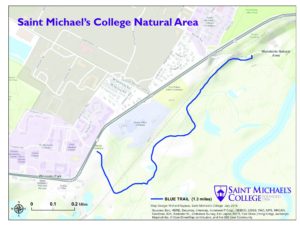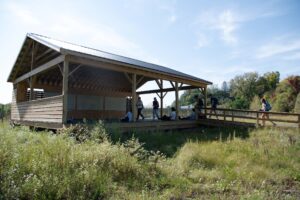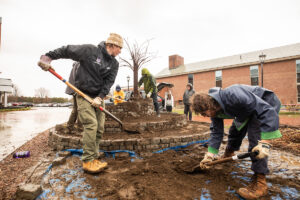Environmental Education
Environmental Education is both content and an approach to education. What’s more, at the Institute for the Environment, we work to integrate environmental teaching and learning into the liberal arts focus of our college and use the pedagogy of the Institute to deliver the liberal arts.
At Saint Michael’s College, environmental education is accessible to all students, faculty, area public school students, and the community. We strive to create outdoor classrooms accessible to all. Here at Saint Michael’s College, learning has no walls, is integrated into coursework, life, and living, in formal, informal, and non-formal ways. Through environmentally focused coursework and use of our outdoor classrooms students steward the land, grow and eat local foods, or explore and remediate the Winooski River ecosystem. There are many opportunities to learn with, for, and about our environment for our students, faculty and the community.
Outdoor & Living Classrooms
Driven by an environmentally conscious and supportive community, the Institute for the Environment supports and accesses a multitude of on-campus programs, locations, and endeavors focused on environmental education including the Farm, the Natural Area, the Teaching Gardens, the Pavilion at the Natural Area, and the Campus Facility at large. The Institute works not only to maintain these highly-valued “outdoor classrooms,” but also to render support, gain awareness, and further development in their areas.
While students access all resources at Saint Michael’s to live and learn, the Farm, the Teaching Gardens, the Natural Area, and the Facility serve as the primary classrooms for students to take their learning out of doors. Students find inspiration, collaboration and application to the theory and knowledge they build throughout their courses. Our students strive to learn for, in, and about the environment in these spaces.
Where We Steward Environmental Education on Campus
The Natural Area

A map of the Saint Michael’s College Natural Area
The Natural Area is undeveloped and includes wetlands, sand plain forest, floodplain forest, and fields to explore. A small portion of this area is occupied by our solar array, compost facility, waste-water pumping station, geothermal infrastructure to heat the newest campus building, and salt, mulch, and topsoil staging necessary for maintaining the grounds. The vision for this property is to restore and improve natural habitats in this area while expanding research, education, and recreational opportunities for the college community. It is located across the street from campus, just off of the jug handle light. There are many trails that are clearly marked and a map that is available for students, faculty and the community.
The Teaching Pavilion at the Natural Area

Down the hill, on the road accessing the Natural Area, on the right and set off a bit from the road, you will find a brand new lean-to ready for outdoor learning. The structure has a roof, a platform for at least 20 students, a long white board, and access to tables and chairs in a small, locked shed behind the whiteboard. There is a ramp for wheelchair accessibility. Please use the form linked on the Faculty Resources button to schedule a visit with your class.
Teaching Gardens

Created by Professors Valerie Bang Jensen and Mark Lubkowitz, the Teaching Gardens is inspired by our botanists, teachers, and children’s-literature scholars. You’ll find a children’s literature garden called Books in Bloom, which features plants from favorite story books. Next door, flora native to our region of Vermont can be studied up close in our Native Plants of Vermont garden. Lastly, a different kind of garden: movable words, artistically etched on pieces of stone scattered upon a bed of pebbles, allow passers-by to create their own poetry in our Word Garden (one of a kind!). The Teaching Gardens are located between Saint Edmund’s Hall and the McCarthy Arts building.
The Farm

The Farm is coming up on ten years of food production for the SMC community. Located across the street from campus and behind the Pomerleau Building, the Farm is a resource that creates learning opportunities and food for our community. Visits to the farm can be coordinated by filling out the form in the Faculty Resources and are a great way to infuse your class with service and hands-on learning.
Other Ecological Zones

We host a variety of spaces on campus that support biodiversity, pollinator habitat, and provide other ecosystem services to the SMC community. Our on-campus ecological zones include the Spiral Garden, Pollinator Garden, Tree Nursery, Raised Bed Garden, our No-Mow Zones, and so much more! These spaces scattered around campus are hot spots for environmental projects and learning.
Students and employees should feel free to host meetings in these spaces, as well as schedule events here. We do request that you still reserve the space through our form. Please leave any of the on-campus ecological zones trash-free and as you found it.
The Natural Area

A map of the Saint Michael’s College Natural Area
The Natural Area is undeveloped and includes wetlands, sand plain forest, floodplain forest, and fields to explore. A small portion of this area is occupied by our solar array, compost facility, waste-water pumping station, geothermal infrastructure to heat the newest campus building, and salt, mulch, and topsoil staging necessary for maintaining the grounds. The vision for this property is to restore and improve natural habitats in this area while expanding research, education, and recreational opportunities for the college community. It is located across the street from campus, just off of the jug handle light. There are many trails that are clearly marked and a map that is available for students, faculty and the community.
The Teaching Pavilion at the Natural Area

Down the hill, on the road accessing the Natural Area, on the right and set off a bit from the road, you will find a brand new lean-to ready for outdoor learning. The structure has a roof, a platform for at least 20 students, a long white board, and access to tables and chairs in a small, locked shed behind the whiteboard. There is a ramp for wheelchair accessibility. Please use the form linked on the Faculty Resources button to schedule a visit with your class.
Teaching Gardens

Created by Professors Valerie Bang Jensen and Mark Lubkowitz, the Teaching Gardens is inspired by our botanists, teachers, and children’s-literature scholars. You’ll find a children’s literature garden called Books in Bloom, which features plants from favorite story books. Next door, flora native to our region of Vermont can be studied up close in our Native Plants of Vermont garden. Lastly, a different kind of garden: movable words, artistically etched on pieces of stone scattered upon a bed of pebbles, allow passers-by to create their own poetry in our Word Garden (one of a kind!). The Teaching Gardens are located between Saint Edmund’s Hall and the McCarthy Arts building.
The Farm

The Farm is coming up on ten years of food production for the SMC community. Located across the street from campus and behind the Pomerleau Building, the Farm is a resource that creates learning opportunities and food for our community. Visits to the farm can be coordinated by filling out the form in the Faculty Resources and are a great way to infuse your class with service and hands-on learning.
Other Ecological Zones

We host a variety of spaces on campus that support biodiversity, pollinator habitat, and provide other ecosystem services to the SMC community. Our on-campus ecological zones include the Spiral Garden, Pollinator Garden, Tree Nursery, Raised Bed Garden, our No-Mow Zones, and so much more! These spaces scattered around campus are hot spots for environmental projects and learning.
Students and employees should feel free to host meetings in these spaces, as well as schedule events here. We do request that you still reserve the space through our form. Please leave any of the on-campus ecological zones trash-free and as you found it.
